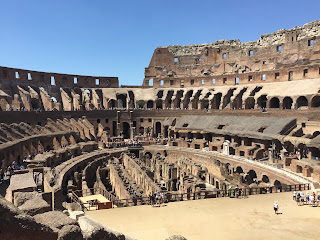Rome is old. Old in a way most places are not. It;s not as old as Greece or Egypt. But it's plenty old.
Today I walked through the remains of the Imperial Palace on Palatine Hill. A palace so ancient it is the literal origin of the word 'palace'. It was hard, among the ruins, to imagine the day-to-day lives of the emperors and citizens and slaves. But I imagine they too complained about the heat, enjoyed the view, and thanked their good fortune to be where they were. Well, probably not the slaves so much, but the other ones definitely.
After the Palatine and the Forum (the heart of Roman society) it was onto the Colosseum. Tickets and entry for the Palatine were quick but even with the ticket that was good for the Colosseum it would've been a hell of a long wait, especially with the added crowds thanks to the Vatican Museums being closed. So I opted to skip the line with a guided tour. Fifteen Euros. Easily the cheapest of the line-skippy tours, thanks to my already having a ticket. The tour was short and basically told me nothing new, except the extent of the rebuilding the Colosseum had already underwent. Still, saved a few hours in the sun, and for that I was grateful.
It is as massive and impressive as you imagine it might be, but at the end of the day it's still a ruin--just a shell of the blood-splattered house of spectacles it once was.
Now, as mentioned previously, the Vatican museums (which include the Sistine Chapel--no pictures allowed) were closed today due to Italian holidays. Thankfully, I went yesterday. It was sort of a reverse-Louvre. They put the chapel at the end of the museums -- past statues, and paintings, and tapestries (SO MANY TAPESTRIES). They leave the good stuff for the end. It truly was impressive--both the ceiling and the Last Judgment--even in an impossibly crowded chapel, where security guards would continually get on loudspeakers to remind people to be quiet.
Before the museums I waited in the line for St. Peter's Basilica. It's the largest church in the world but still technically considered a basilica rather than a cathedral because it has no full-time bishop. I've been to plenty of impressive churches, but St. Peter's, as expected, rises above them all. Gorgeous statues and art adorn every surface and it even has its own Michelangelo -- the Pieta (the look on Mary's face is heartbreaking).
I paid an extra few Euros to go into the treasure gallery(also no pictures allowed). I was expecting some golden candelabras and ornate vestments and I certainly got that. What I wasn't expecting where the reliquaries. For those who don't know, a reliquary is an ornate box or holding container for a relic -- which is usually the body part of a saint. So I found myself wide-eyed staring at a man's face etched in gold that apparently held the skull of St. Luke the Evangelist. You know the New Testament? Yeah, that guy. I don't know if there actually was a skull in there but the reliquary next to it (of another saint) definitely had one -- it was completely visible under glass. No one else seemed to notice it but me.
Now St. Peter himself is said to be buried underneath St. Peter's, and there is a reliquary of his finger among the other treasures, but for some reason it was St. Luke who stuck with me. The idea that one of the writers of the bible had his skull stuffed in a proverbial jar so that jobbers like me could gawp at it for a couple of Euro, was, I don't know if it was beneath dignity or some absurd form of immortality.
Like I said, I don't know if any of those relics were real.
But they were old. Plenty old.



Comments
Post a Comment